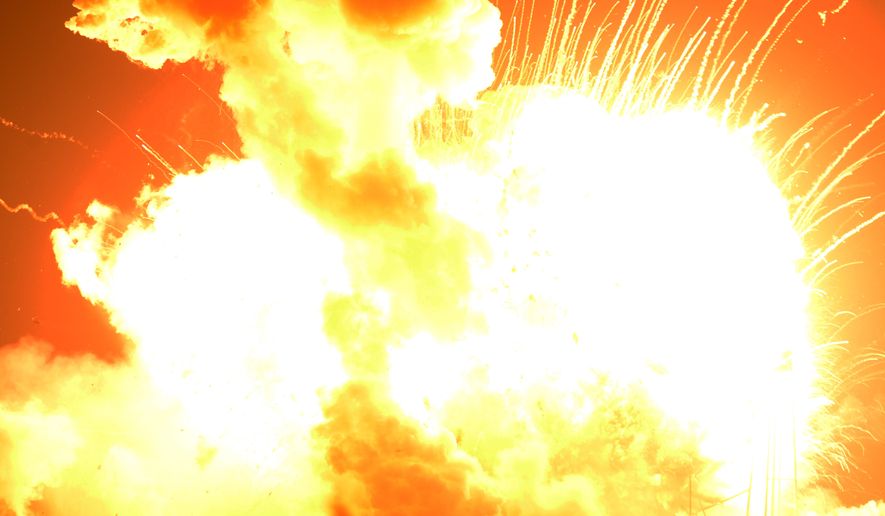An unmanned NASA-contracted rocket powered by a Soviet-era Russian rocket engine exploded Tuesday night along the northeastern Virginia coast, flaring into a massive fireball shortly after it launched from Wallops Flight Facility.
The Antares rocket, which is an American expendable launch system manufactured by Orbital Sciences Corp., was scheduled for liftoff at 6:22 p.m. but burst into flames six seconds after it left the ground. Flames shot into the evening sky, providing dramatic images.
The rocket was carrying roughly 5,000 pounds of supplies to the International Space Station that were going to be used mostly for experimental purposes and scientific investigations.
“We’re happy to report there were no injuries all we lost was hardware,” Orbital Executive Vice President Frank Culbertson said at a Wallops-based press conference Tuesday night. “That hardware, however, was very important and of high value to our customers. Something went wrong and we will find out what it is.”
Part of that hardware included a rocket engine that is rich with Cold War history and emblematic of brilliant Soviet aerospace engineering — engineering that remained a secret until Americans discovered it after the fall of the Soviet Union.
The Antares is powered by a modified NK-33 rocket engine, a legendary relic that was originally developed for the N-1 Soviet Moon Program by the Kuznetsov Experimental Design Bureau in the 1960s and 1970s.
Mr. Culbertson, a former astronaut, said officials don’t know whether the Antares’ rocket engine was the cause of the explosion.
“The history of this engine has been well-documented in our proposal to NASA. It’s an extensively tested engine, it’s very robust and rugged and it goes through extensive testing. These engines were taken through the normal testing. We didn’t see any anomalies,” he said.
“It was proven in testing in Russia and when you look at it there aren’t many other options for an engine like this around the world, even in this country,” he said.
The history behind the NK-33 remains one of the most ironic chapters in space history.
The engine was considered a breakthrough in aerospace because it used oxygen-rich, closed-cycle technology, a process American engineers thought was just science fiction. The NK-33 was the first engine ever to recycle rocket fuel exhausted from its pre-burners.
In a 2001 British television documentary, “The Engines That Came in From the Cold,” Lockheed Martin program manager Robert Ford said, “It wasn’t the same technology we were used to. It was a paradigm shift in what we were expecting.”
Even today, U.S. aerospace engineers cannot duplicate the age-old Soviet technology.
But the NK-33 almost had a tragic ending. Despite its incredible technology, the Kremlin ordered the destruction of all its NK-33 engines in 1974 when it conceded defeat in the moon space race. The space program had lost its political value, and the Politburo decided it was better to destroy the engines and close the Baikonur Cosmodrome in Kazakhstan.
Defying the Kremlin, however, the Soviet aerospace engineers who still believed in the engine hid more than 60 in the small town of Samara, more than 1,000 miles from Moscow. They remained hidden there for decades until the Soviet Union collapsed, and NASA began a partnership with the Russian Federal Space Agency to build the International Space Station.
The RD-180 has since become a source of political controversy since the Ukraine crisis, and Russian officials threatened to cut off America’s rocket engine supply. Critics say the U.S. should not rely on Russian-made rocket engines to launch national security satellites.
For a Sept. 4 article, officials at the Russian Embassy in Washington told The Washington Times that U.S. rocket manufacturers have been attracted to their engines for space launches because of their quality.
NASA and Orbital officials said Tuesday that they were not deterred by the explosion and believe it can provide lessons to improve launch safety and success.
Mr. Culbertson said, “We’ll continue to learn from this investigation. We’ll figure out what the failure was, we’ll learn from it and expand it to other rockets and engines.”
White House principal deputy press secretary Eric Schultz said President Obama had been briefed on the blast and “will continue to get updates as more information becomes available.”
• Jeffrey Scott Shapiro can be reached at jshapiro@washingtontimes.com.




Please read our comment policy before commenting.